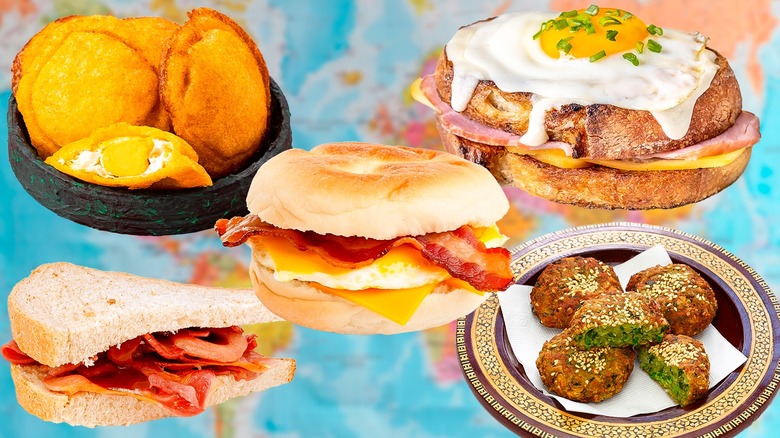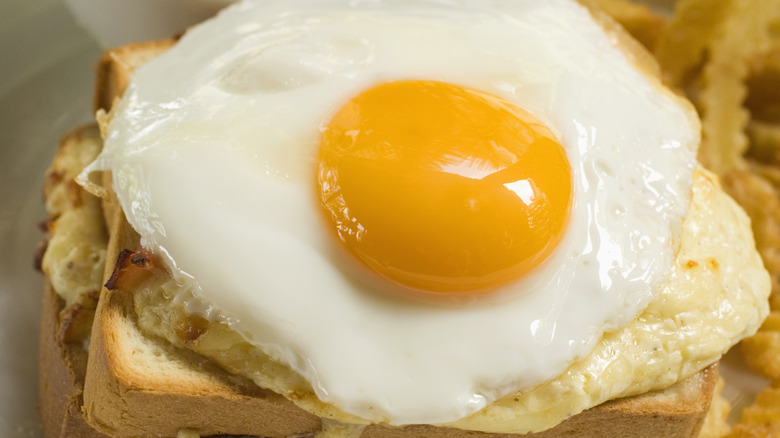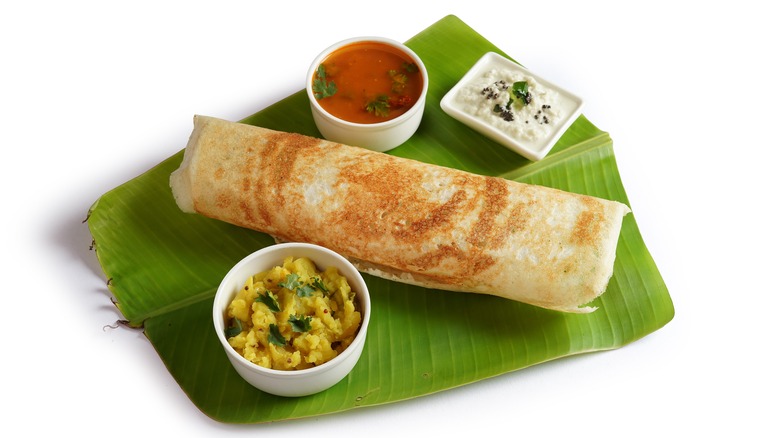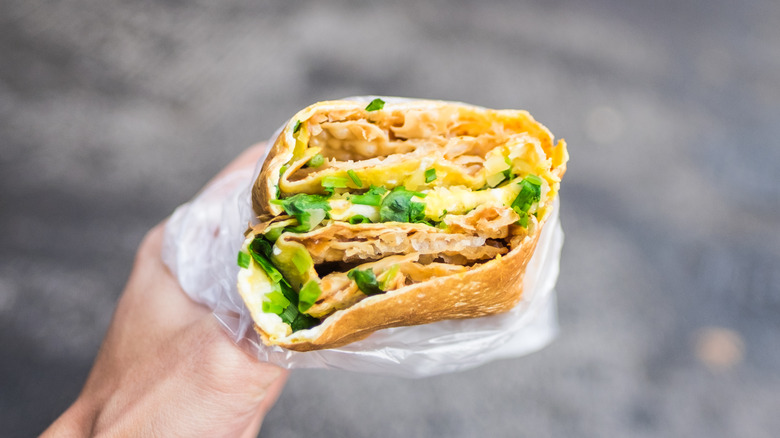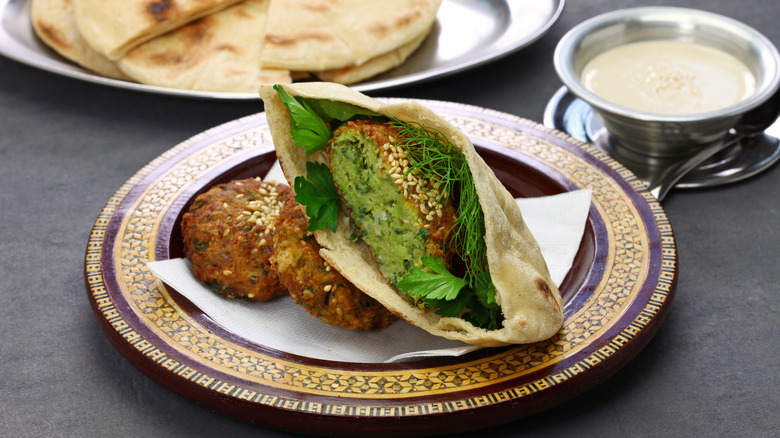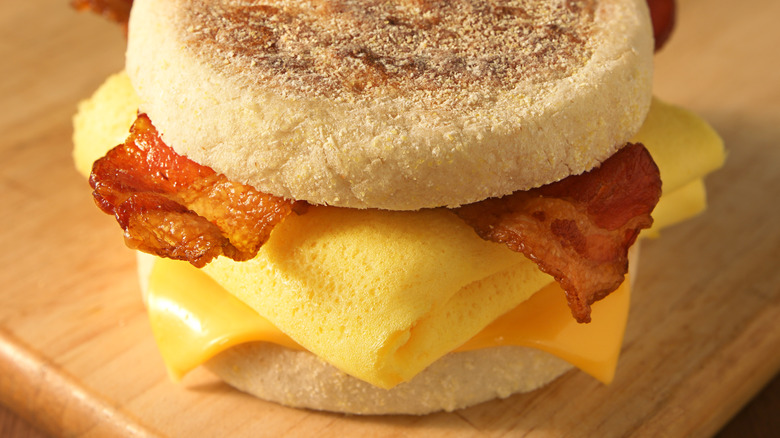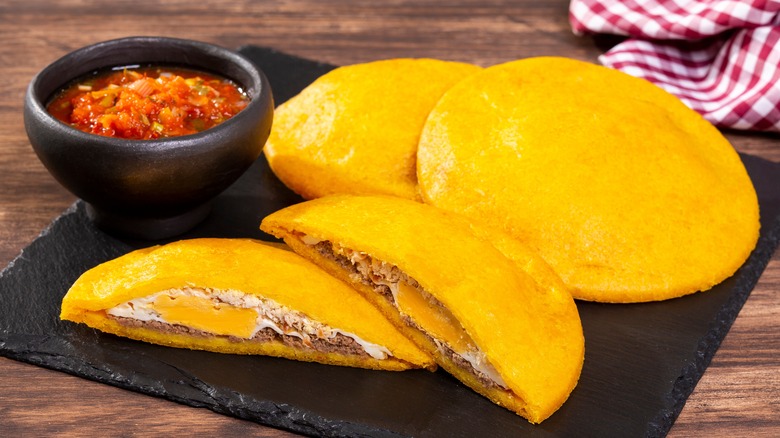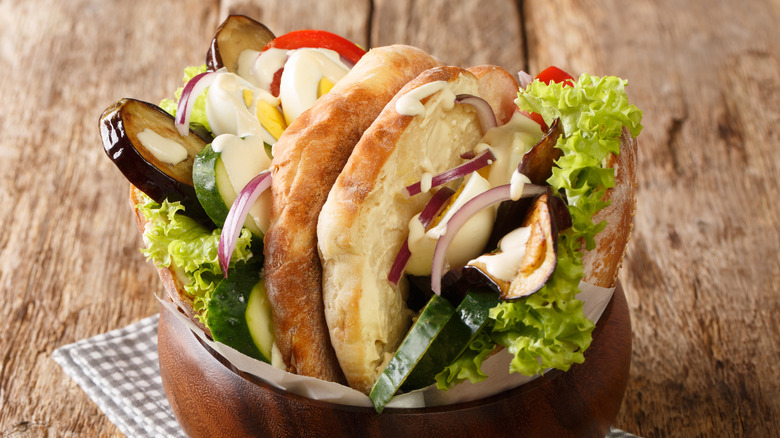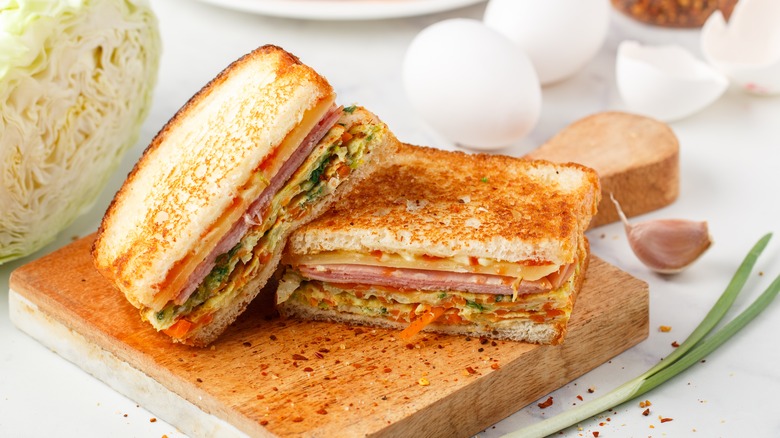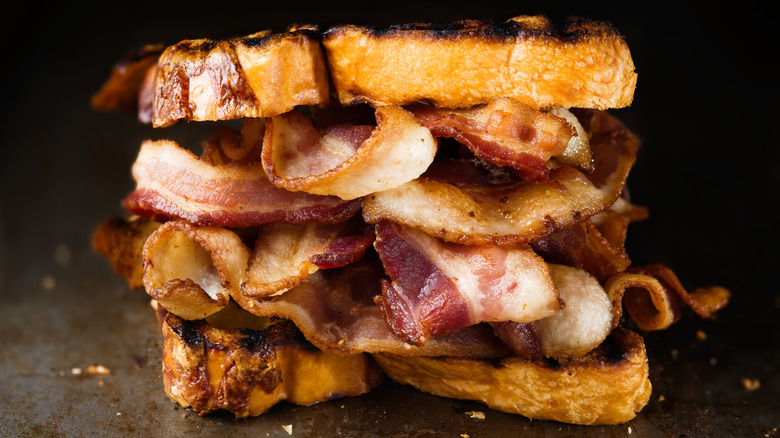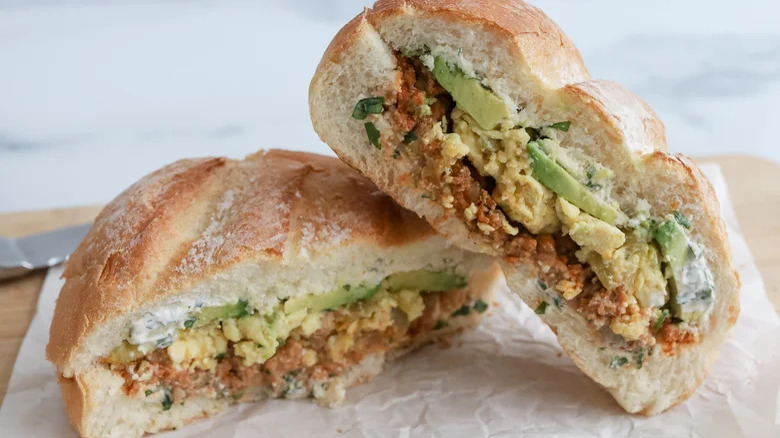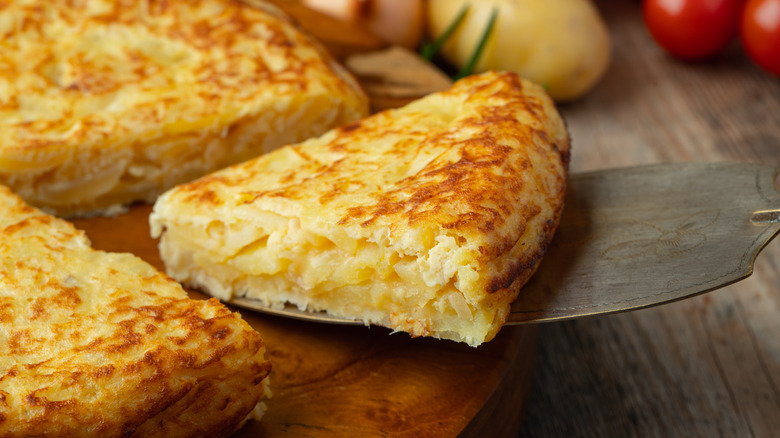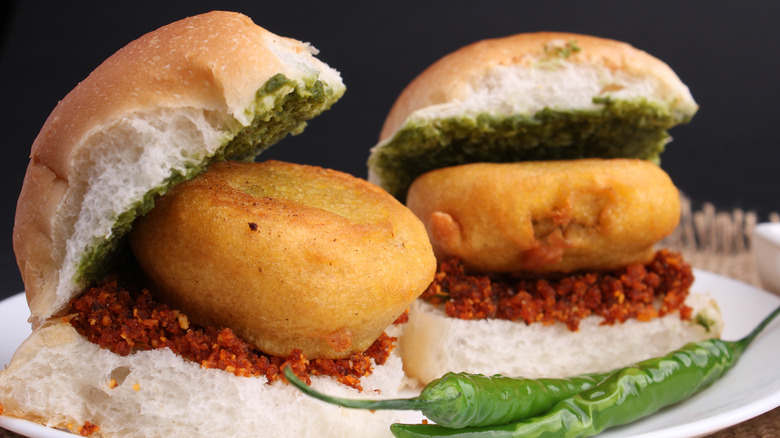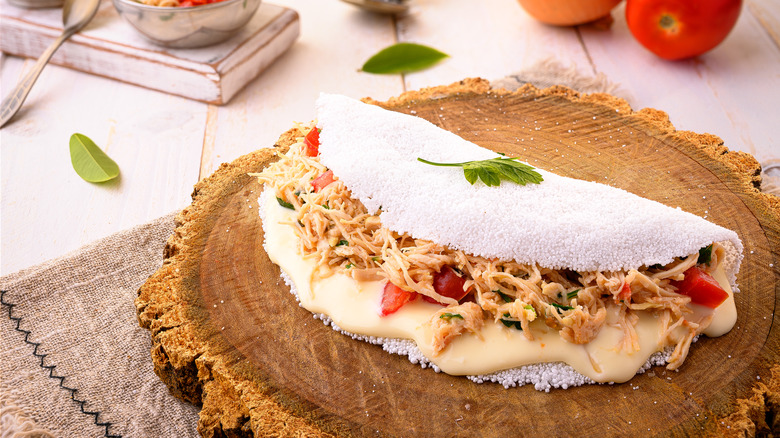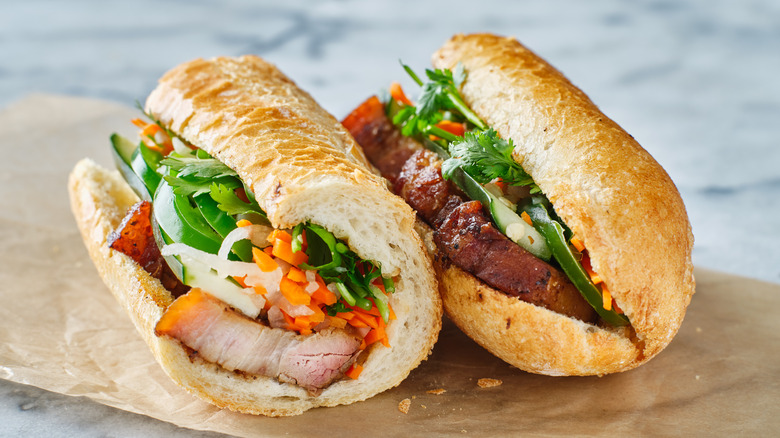14 Breakfast Sandwiches From Around The World
Breakfast sandwiches are an ideal way to quell those morning hunger pangs — especially when you're short on time and need something manageable to eat as you walk to the subway or get in your car. These handheld wonders offer a perfect amalgamation of flavors, textures, and nutrients that don't need to be enjoyed leisurely at the breakfast table (although they certainly can be eaten that way, too). Not only that, but breakfast sandwiches, like other foods, can adapt to the typical ingredients and traditions followed by various cultures worldwide. In other words, Americans may love sandwiches, but we do not have a monopoly on them by any means.
So, as much as you may enjoy a classic bacon, egg, and cheese on a bagel, it's time to look beyond the familiar and embrace the variety of breakfast sandwiches. Here are some of the wild and wonderous variations of breakfast sandwiches worldwide.
1. Croque madame (France)
Both the croque madame and the croque monsieur are made with melted Gruyére cheese and ham. But the main difference between these two sandwiches is exactly what makes the former a breakfast sandwich and the latter just a regular one. The croque madame includes a fried egg, which is an ingredient commonly associated with breakfast.
Aside from that, you may find that your next croque madame differs slightly from the one you had at that cute little bistro last week. That's because, as with any recipe, there are a number of creative twists that can be applied to it. For instance, don't be surprised if your open-faced sandwich has been dipped in whisked eggs before it was cooked or if it's on brioche bread instead of a sourdough slice. Likewise, you may experience a croque madame made with a range of different cheeses or hams. This is nothing to be afraid of. Each and every iteration is likely to be as tasty and filling as the next.
2. Masala dosa (India)
Breakfast in India can go hard on the spice front, which is the case for the masala dosa. It can be eaten for breakfast, lunch, or dinner. You might be wondering why India didn't just come up with a different type of food to start the day instead of repurposing the ubiquitous dosa for yet another meal. After all, it's not like Indian cuisine has a shortage of ingredients or creativity.
The answer is that, historically, breakfast food just wasn't its own category of food. The concept of breakfast as a meal didn't really take in Southern India until the 17th century, after the arrival of British colonists. Before that, many people skipped breakfast and went straight to lunch because it worked best for their agrarian lifestyles. Although Western breakfasts, like cereal, have become more popular, the culture has still clung on to its regional favorites — like the dosa.
If you want to try making breakfast dosas at home, be sure to prepare the batter in advance. It must rest for at least eight hours before you can use it. Once it's finished cooking, fill your breakfast dosas with flavorful fillings like seasoned potatoes and coconut chutney.
3. Jianbing (China)
Bread is not a particularly big hit in China, at least not as much as in the U.S. So, when it comes to sandwiches or sandwich varieties, you're more likely to find a starchy exterior made from a different kind of batter. That's the case with jianbing, a Chinese crepe made with mung bean flour. After it's cooked, it's filled with delights like eggs, hoisin sauce, and fried wontons.
When making this recipe, it's important to spread the thin batter across the pan evenly, or you might have some problems at the folding stage. The key to this dish is to fit in all the tasty, texturally interesting fillings without breaking the crepe. The structural integrity of the crepe is especially essential if you're planning on chowing down on this breakfast sandwich on the go. You don't want anything too loose and messy; otherwise, you risk spilling the contents of your crepe or your crepe on your new suit right before that big presentation!
4. Ta'ameya (Egypt)
Middle Eastern falafels, made with chickpeas and fashioned into sandwiches with pita bread, are so ubiquitous that they may be just as common on the streets of New York as they are back in their countries of origin. But there is another type of sandwich you should know about, called a ta'ameya, which is similar to falafel in flavor and texture but made with fava beans instead of chickpeas.
Some historians even believe that the fava bean patty was the original falafel. They speculate it was created to cater to the palates of British soldiers that occupied the country starting in 1882. The result was the ta'ameya, which would become the base of an excellent breakfast sandwich. Egypt's breakfast eaters prefer to enjoy the ta'ameya in the morning, especially when it's tucked into a traditional, pita-like flatbread called baladi. The dish is very affordable, meaning all social classes can eat it. The sandwich also often comes served with chopped onion and tomatoes (not unlike a falafel sandwich), which helps add a reprieve from the greasiness of the patty.
5. Egg sandwich (United States)
You can hardly go wrong with an egg sandwich. Just cook up some scrambled eggs or an omelet, slap it between two slices of your favorite bread (or some alternative), and you'll be left with a perfectly satisfying and portable breakfast. The simplicity and ease of this operation is one of its biggest draws. There are also countless variations of the humble egg sandwich. You could add bacon, ham, a variety of cheeses, and condiments and you still wouldn't be able to ruin this beloved American dish.
There are tons of ways to build on this classic, including variations like our ultimate bacon, cheese, and egg sandwich. To make this one, just grab a toasted English muffin, spread a mixture of sriracha and butter on both slices, and assemble the sandwich with crispy fried bacon, eggs scrambled in the bacon grease, and cheddar cheese. Be sure to stick the cheese in the sandwich as soon as possible so the hot bacon and eggs can help melt it.
6. Arepa de huevo (Colombia)
When in Rome, do as the Romans, but when you're in South America, especially countries like Colombia and Venezuela, eat arepas. This staple starch is used in a similar way to pita bread. The cornmeal-based patty is fairly hollow in the middle and can accommodate any filling you choose. Plus, it's a recipe that can easily be made gluten-free, which is not the case for other wheat-based sandwich breads.
The breakfast component comes in with the fillings. While it's possible to eat arepas at any time of the day or night, arepa de huevos can function as an above-average breakfast experience. And it's incredibly simple to make — because who wants to create a complicated meal first thing in the morning? Just make the arepa dough, fry it up, and crack an egg into the center pocket of each one. Then, you'll want to cook the patty until the egg white has solidified.
7. Sabich (Israel)
The sabich, a Middle Eastern stuffed sandwich, is believed to have originated in Israel's Iraqi-Jewish community. It is typically made with fried eggplant, hard-boiled eggs, pickled vegetables, hummus, tahini sauce, amba sauce, and a fresh Middle Eastern salad, all stuffed into a warm pita. The amba sauce, made with pickled mangos, provides a nice sweet and sour addition to the sandwich, bringing it firmly into the realm of breakfast food. However, it can be consumed at any time of day.
The sandwich's story was said to have begun in the 1960s at a humble Israeli street food stand run by an Iraqi man named Sabich. Bus drivers liked to stop there for a bit in the early mornings, so they asked Sabich to provide something that was both breakfast-worthy and portable. The inventive man reportedly thought to simply put the contents of his typical Iraqi breakfast inside a pita-like bread called laffa. The result was the sabich sandwich, which is filled with the delicious, vitamin-packed veggies that anyone would need to start their day on the right foot.
8. Street toast (Korea)
Korean cuisine pairs sweet and savory flavors better than most, so it's no surprise that this flavor combination can also be found in Korean street toast, also known as Gilgeori toast. It's a tasty and filling sandwich often enjoyed as a quick breakfast or dinner throughout South Korea. You'll find an egg, vegetable patty, ham, and cheese, all stuffed between two slices of sweet buttered bread.
But the kicker comes with the combination of ketchup, mayo, and jam or sugar, which adds the sweetness needed to turn this savory sandwich into something that is greater than the sum of its parts. And if you're worried about the vegetable patty part, which calls for shredded carrots, cabbage, and other vegetables, fear not. You can swap it out with a bag of pre-packaged coleslaw mix. This patty will add flavor, texture, and a pop of color to your sandwich.
9. Bacon butty (United Kingdom)
The British are not known for having the most flavor-forward cuisine, as evidenced by its soggy peas and bland porridge. But the truth is that the Brits have plenty to be proud of in the kitchen, especially when it comes to pork-forward dishes like bangers and mash or bacon butties. These bacon butty sandwiches are made with a thicker, wider version of American bacon (called Irish bacon or rashers), bread, and butter. The "butty" part of the name is a quintessentially British way to shorten the word "butter."
Although it's a simple sandwich, you can still add your condiment of choice to this sandwich. Many bacon butties are served with some ketchup or a malt-vinegar-based condiment called HP Sauce. You can enjoy this sandwich at any time of day, but you may crave one in the morning after drinking a tad too much the night before.
10. Torta de huevo con chorizo (Mexico)
When looking for a breakfast sandwich south of the border, consider a torta de huevo con chorizo (chorizo, egg, and cheese torta). This meal consists of a combination of regional breakfast staples on a toasted Mexican torta called a telera. The spiciness of the crumbled chorizo sausage is coupled with the creaminess of the eggs and refried beans, which makes for a diverse and delicious bite.
To make sure this torta comes together seamlessly, start by toasting the bread in the oven before spreading a rich and tangy sour cream crema on each slice. Finish by layering cooked eggs with green chilies, warmed diced chorizo, and cooked refried beans with fresh queso fresco. Finish off the sandwich with some fresh diced avocado before closing and enjoying it.
While this sandwich is a complete meal — with plenty of protein, vegetables, and starches — and can certainly be consumed alone, you can also pair it with some breakfast potatoes or home fries for an extra filling dish.
11. Bocadillo de tortilla (Spain)
The Spanish tortilla, a staple made mostly with eggs, potatoes, and onions, is not seen only as a breakfast food in Spain. It is commonly eaten for lunch or dinner and comes in many varieties, including with vegetables, meat, or herbs. But when you stuff it between bread, you get a whole different food. This rendition is called the bocadillo de tortilla, and it's an excellent portable breakfast. It can be made with a variety of fillings, including eggs cooked in any style, cheese, chorizo, and beans.
While making a Spanish tortilla can be a bit of work, especially for an early morning meal, you can easily prepare this part ahead of time and refrigerate it until you're ready to assemble your sandwich. Then, just heat up the tortilla and stick it between two slices of good-quality baguette. But if you can't handle a sandwich without condiments, don't be afraid to drizzle on some ketchup or sriracha mayo. When dealing with eggs and bread, you can't go wrong with these flavorful additions.
12. Vada pav (India)
Indian food varies considerably from region to region, which is why a typical Indian restaurant in the U.S. may only include a small representation of the country's cuisine. One item you may not have encountered yet is vada pav, a fried potato sandwich that originated in Mumbai. These sandwiches are commonly sold by street vendors, but you'll also find them in formal restaurants, too.
More specifically, the sandwich is made up of a spiced potato filling coated in a chickpea batter and fried. But the most important part of this dish, and a source of flavor variety, is the chutney. You can change the whole vibe of a vada pav just by changing the chutney. You'll find garlic chutneys made of mint, coriander, tamarind, or coconut. The chutney complements a well-cooked patty, so you'll want to be sure the inside of the vada pav is soft and the outside is crispy.
13. Tapioca (Brazil)
Brazilian tapioca is nothing like the mushy tapioca pudding its name may bring to mind. Its texture is very much the opposite of mushy; it features a crisp but firm shell stuffed with practically any filling, from pulled pork to sweet Nutella. The tasty street food can be consumed for breakfast and lunch alike, depending on what's in it.
The crisp tapioca shell offers a portable, tasty, and gluten-free outer layer to help support whatever filling you choose. To make it yourself, just mix tapioca starch with a bit of water, making sure it remains fairly dry. Flatten the mixture onto a nonstick pan and cook it for 30 seconds, and then you'll be ready to customize it with your fillings. The tapioca wrapper is best eaten when it's warm and pliable and has very little taste when eaten solo. So, it's a blank slate to play with different flavors and craft a unique breakfast "sandwich" that you may not expect.
14. Bánh mì (Vietnam)
While the Vietnamese bánh mì sandwich is well-known in most American cities, it tends to be eaten for lunch, dinner, or as a 3 a.m. snack when the only Chinese and Vietnamese restaurants are still delivering on your food app. But in Vietnam, this versatile sandwich is also enjoyed for breakfast.
It's up to debate whether the bánh mì should be considered a traditional recipe. The bread component resulted from the French occupation in the late 1800s. The colonists brought along their plentiful wheat stores and started making French bread. Eventually, the locals adopted their own style of Vietnamese baguettes and eventually used them to sandwich an array of fillings, like marinated chicken thighs or charred pork. You'll also find recipes with protein-rich egg fillings, as well as ones that utilize regional spices and flavors. Regardless of the filling, the bánh mì is one sandwich that hits the spot any time of day.
